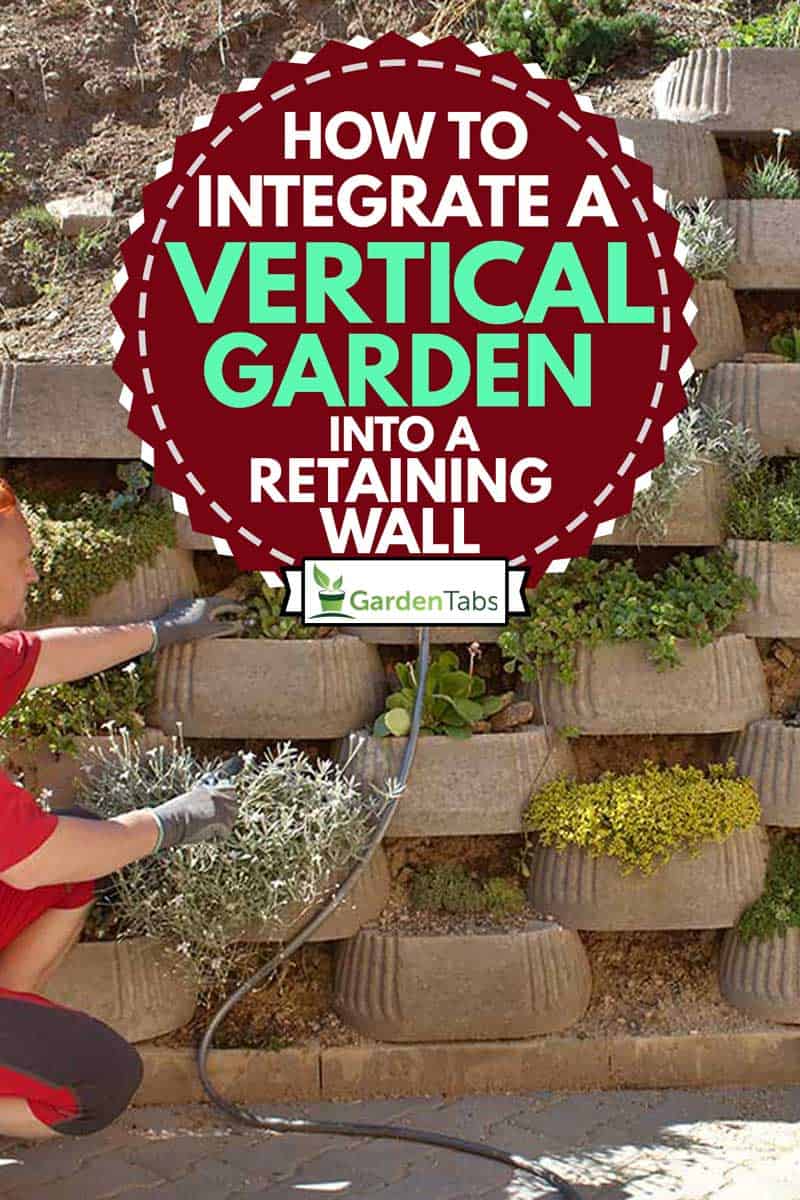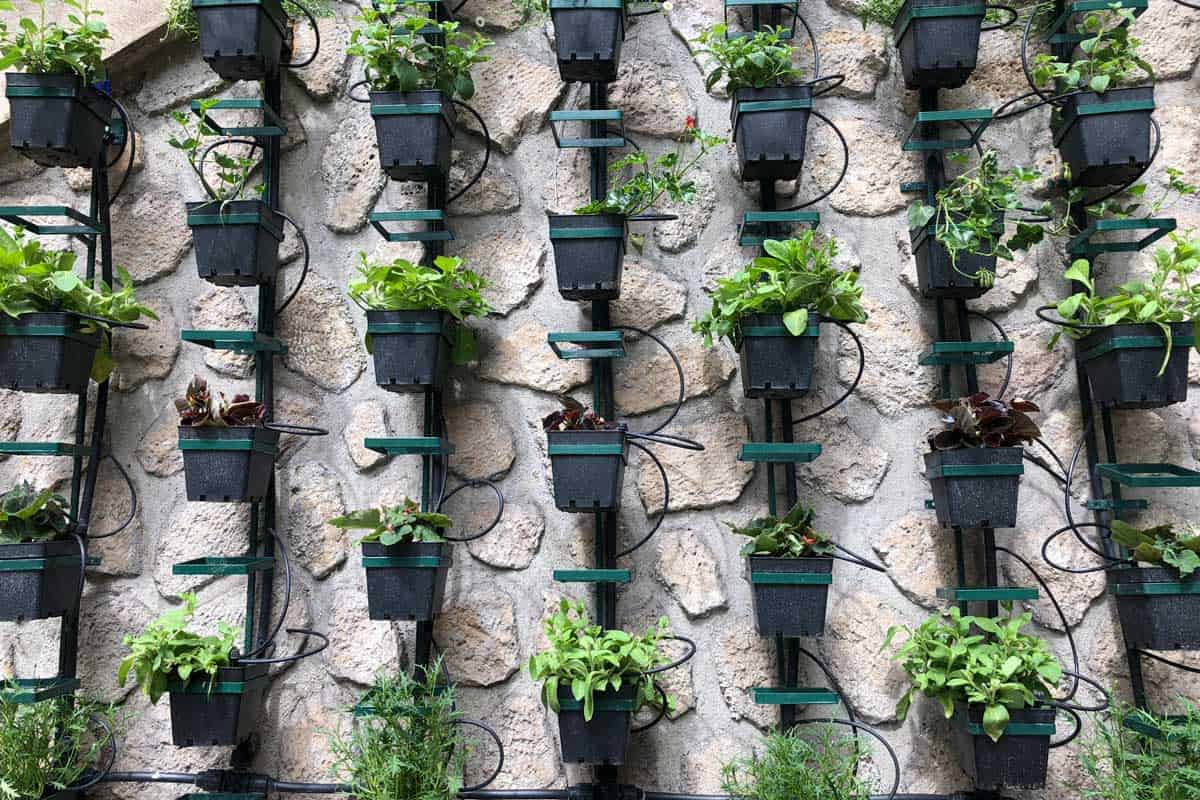 Gardens provide a place for peace and relaxation, where the gardener can enjoy the fruits of his or her labor in scenic beauty. But what if you have to work around a plain, boring retaining wall? Can you integrate a vertical garden into a retaining wall so it is a thing of beauty instead of an eyesore? I have researched this very question and am happy to share my results with you.
Gardens provide a place for peace and relaxation, where the gardener can enjoy the fruits of his or her labor in scenic beauty. But what if you have to work around a plain, boring retaining wall? Can you integrate a vertical garden into a retaining wall so it is a thing of beauty instead of an eyesore? I have researched this very question and am happy to share my results with you.
It is very possible to create a vertical garden from a retaining wall. To do so, you will need to do the following:
- Know what type kind of wall you have, as walls with crevices can house cascading plants,while smooth faced walls may require a support system for climbing plants.
- Determine the location of the Wall- full sun, partial shade, or full shade?
- Choose what plants to use- Do you want cascading, climbers, a combination of both?
- Build a drip irrigation system.
- Maintain your garden by providing fertilizer and pest control.
Creating a vertical garden from your retaining wall is a surefire way to add visual interest to your garden as well as maximize the space that you have. Below is more information that will help you transform your bland, boring retaining wall into the garden of your dreams!
What is a retaining wall?
A retaining wall is a wall built into a landscape to hold back the earth at a slope that it would not naturally keep to. They are used open up additional level yard space, and to support embankments and prevent mudslides from occurring. They are often used to terrace yards that have a steep slope. They are very useful, and often decorative.
Reasons to Create a Vertical Garden from a Retaining Wall

Most retaining walls are the perfect location for a vertical garden. Depending on what type of wall they are, they can provide plenty of alcoves to tuck plants as well as adequate support for climbing plant varieties.
Maximizing Growing Space
Transforming your retaining wall into a vertical garden maximizes the growing space that you have in your garden. It can provide ample room to add more herbs, fruits or vegetables to your gardening repertoire.
Beautifying Your Space
Also, a careful designed retaining wall garden can become a beautiful focal point for your yard. Depending on the plants and flowers that you choose, you can add color and depth to a plain, boring wall.
Types of Retaining Walls
There are a few different kinds of retaining wall, and the type that you have will determine how to plant your vertical garden and chose your plants.
Reinforced Wall
A reinforced wall has a layer of material such as stone behind the visible wall itself that provides additional support for the soil behind the wall. The outside wall is generally poured cement, creating a monolith with smooth sides. They can be poured around rebar, which reinforces the strength of the cement.
These are the types primarily used in basements, in areas with potential for seismic activity, and other locations where an added layer of support would be beneficial.
Smooth surfaces are not as ideal as some of the other types of walls because they do not naturally have any place for plants to grow or cling to.
It is still possible to transform one of these wall into a masterpiece,but you will need to provide a structure such as a trellis for any climbing plants so they have something to attach themselves to.
Stone Retaining Walls
Stacked stone retaining walls are a gorgeous addition to any landscape. They are perfect for adding plants to, as the stacked stones provide ample spaces that plants can be tucked into and vine suckers something to cling to.
Brick Retaining Walls
While similar to stone retaining walls, brick walls are usually more structured and neater in their build. They will not have as many openings for plantings, but they will provide great support for cascading plants that are planted along the top of the wall, as well as climbing plants that grow from the ground up.
Gravity Walls
A retaining wall that relies solely on its own weight to stand up is called a gravity wall. They depend on their own mass to hold back the soil.
What Plants are Best for a Retaining Wall
The best plants to create a vertical wall garden on your retaining wall are cascading plants, climbing plants, or better yet, a combination of both. I have listed a few below, for additional ideas, you can refer to The Best Cascading Plants for a Wall Garden .
Cascading Plants
Strawberries
Strawberries are a great choice that can provide you with berries. They can be planted up top of the wall, then tucked into small crevasses in the stone with a bit of soil and they will sent out runners that will take root anywhere there is a little space. They have a shallow root system, so the wont damage your wall, either.
Sweet Potato Vines
Sweet potato vines are easy to grow, and come in a variety of colors from chartreuse to purple, to red. If you plant them along the top of the wall, they will spill over, growing long, lush masses of color.
Creeping Phlox
Creeping Phlox is an easy pop of color that favors the conditions provided by a retaining wall. Available in various colors, they will grow into a bright carpet across the stone work.
Upright climbers
Roses
Climbing roses look beautiful against a retaining wall. They need to be planted in a sunny location with good soil at the base of the wall.You will also meed to provide a trellis system to support the vines as the roses grow up.
Roses require frequent watering and fertilizing. Some roses require more care than others, but the color and beauty provided by a wall covered in rose-scented glory is well worth the effort.
Creeping Fig
Creeping fig is a good option for areas that don’t get a ton of direct sunlight. They are a vines that will grow up and spread all over your wall with impunity. It will need to be pruned periodically.
English Ivy
This is another vine that will rapidly cover your wall. English Ivy will provide a very traditional charm, especially when combined with roses. It does not need any additional support, just occasional pruning to keep it where you want it.
Plants to Avoid
Avoid water loving plants. Retaining walls need to have good draining to prevent damage to the structure.
Don’t chose plants with aggressive, spreading root systems. These can wreak havoc on a retaining wall as the roots spread and grow.
Acid loving plants are a poor choice, as retaining walls are frequently built with concrete and limestone that increases alkalinity in the soil.
Setting Up the Irrigation System
To keep your plants thriving, you will need to set up some sort of irrigation system. A drip system is ideal, as too much direct watering could cause erosion or damage to your retaining wall.
You can create a homemade drip system from pvc pipe with small holes drilled into it and a connection fora water hose at the end. Place this along the roots of your plants, or just along the top of the retaining wall.This type of system will help to prevent damage cause by too much forceful water flow.
Alternatively, there are several commercially available options, like this RainbirdDrip Irrigation Kit that provides everything that you need to get started. A flexible tubing will allow you to secure it at various points on your wall, providing water to any plants that are embedded in the wall itself.
How to Maintain Plants
Once you have your plants growing, you will need to maintain your garden to keep it looking its best. This means that you will need to make sure that you can provide fertilizer and pest control. If you have a very tall retaining wall being able to reach the top plants safely can be an issue.
Fertilizing Your Plants
For climbing plants planted at the base of your retaining wall, this sis a simple enough feat. However, if you have plants that are outside of your reach, this can seem more challenging. The easiest solution is to install a fertilizer injector to an irrigation valve on your drip system. Then you can mix in a water soluble fertilizer as needed and it will be dispensed with the water.
Pest Control
In order to control pests, you will need to have a sprayer that can reach the highest part of your wall, or spray it periodically from a ladder or scaffolding. There are other organic and non-organic pest control options that are water soluble, such as Miracle Grow All Purpose Plant Food.
Enjoy Your New Garden
With a little planning and hard work, and if you make sure that you cover all of the bases listed above, you will have a gorgeous living wall that has transformed into the new centerpiece of your garden!



English Ivy is an invasive spieces in many parts of the world. It’ll kill all the plants and trees around it eventually. This is from experience.
We appreciate that additional information, Ryan.
I was looking for this information relating to such integrate vertical garden into retaining wall. You have really eased my work by posting this article, loved your writing skill as well. Please keep sharing more, would love to read more from you!
Your article is quite helpful! I have so many questions, and you have answered many. Thank you! Such a nice and superb article, we have been looking for this information about integrate vertical garden into retaining wall. Indeed a great post about it!!
Verticle gardens can look amazing. Especially with a retaining wall. Thanks for sharing! Great post!
Integrating a vertical garden into a retaining wall can be a great way to add greenery and interest to your outdoor space.